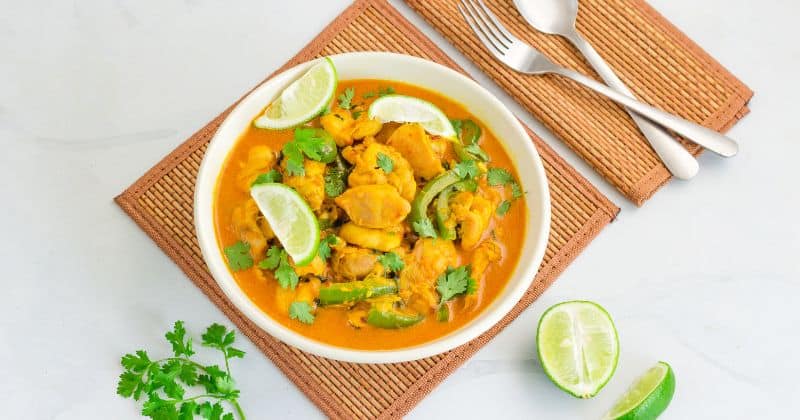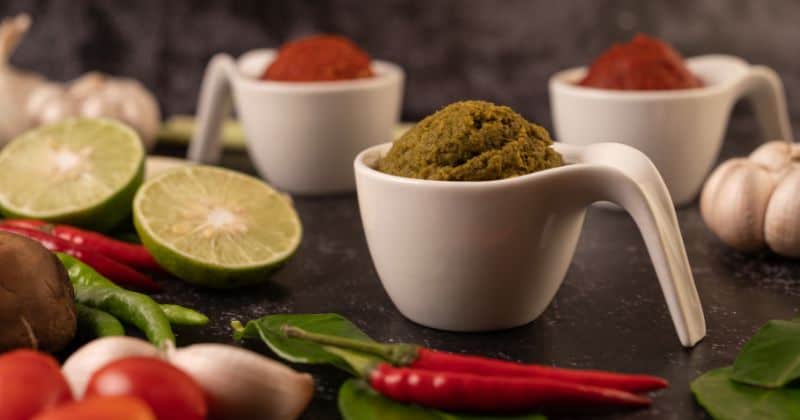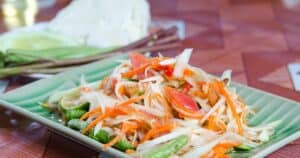Thailand’s rainbow of curries spans from the blistering “hot” red to the aromatic “mild” massaman. So where does rich, golden yellow curry fall on the
The answer is…moderate! Yellow curry ranks around a 3-4 out of 10 on the heat scale compared to its Thai cousins.
This mellower curry features a warm, nuanced blend of spices like turmeric, coriander, cumin and chili. It simmers in creamy coconut milk for a comforting richness.
While not as spicy as the fresh-chili-loaded green or red curries, yellow still brings a pleasant kick. Its layered flavors speak to why it’s become so popular worldwide.
Curious to learn more about yellow curry’s mild yet craveable taste? Read on to discover what sets this aromatic curry apart and how to adjust the
What Is Yellow Curry?

Known as “kaeng kari” in Thailand, yellow curry gets its vibrant color from turmeric and curry powder. This gives it a striking golden hue.
The base paste combines warm spices like turmeric, coriander, cumin, fenugreek, cinnamon, and cayenne pepper. It simmers in a coconut milk sauce along with meat or vegetables.
Common additions are chicken, beef, potatoes, onions, and tomatoes. The ingredients meld into a fragrant, comforting curry that’s perfect over jasmine rice.
While related to Indian curries, Thai yellow curry uses less powder and more fresh aromatics like lemongrass, garlic, and shallots. It has a distinctive Thai flavor profile.
Is Yellow Curry Spicy?
So how does yellow curry measure up heat-wise? Well, yellow curry is milder and less spicy than other Thai curries like red or green.
It ranks around a 3-4 out of 10 on the spiciness scale. Yellow curry gets a pleasant kick from cayenne and black pepper. But the fresh chili heat is toned down.
The spices blend together for a subtle, building warmth rather than an intense, mouth-burning wallop. You taste more of the turmeric, coriander and coconut milk.
The mellow spices allow the chicken, shrimp or veggies to shine rather than just tasting hot. This makes yellow curry perfect for those new to Thai cuisine.
How Does Yellow Curry Compare to Other Thai Curries?
Let’s see how yellow curry stacks up to its cousins:
- Red curry – Also contains dried red chilies but is spicier than yellow at around 5/10.
- Green curry – Loaded with fresh green chilies for an intense 5-7/10
spice level. - Massaman curry – Relies on warm spices like cinnamon; very mild at 2/10.
- Panang curry – Peanutty with moderate
spice around 4/10.
So in the Thai curry lineup, rich and creamy yellow curry is among the least spicy. But it still delivers a gentle chili warmth that beautifully balances the other flavors.
What Makes Yellow Curry Mild?
A few factors account for yellow curry’s tamer personality:
- Turmeric – Bright yellow turmeric adds earthiness more than heat.
- Curry powder – Pre-blended powder contains less chili intensity.
- Cayenne – Cayenne packs less heat than bird’s eye chilies used in other curries.
- Coconut milk – The creamy coconut milk mellows out the
spice blend. - Spice balance – Coriander, cumin, and fenugreek round out chili heat.
The result is a mildly spicy curry where no one flavor overpowers. The nuanced
Adjusting Yellow Curry’s Spice Level
Want to turn up the heat on mild yellow curry? Or need to tame it down? You have options:
- For more heat, add another chopped Thai chili to the sauce.
- For less
spice , remove the chili seeds to lower the burn. - For a creamier, mellower curry, use full-fat coconut milk.
- For extra kick, sprinkle in more cayenne or red pepper flakes.
- For warmth without the chili burn, increase the turmeric and cumin.
- For less intense
spice , cut back on the amount of yellow curry paste used.
Part of the fun is customizing your yellow curry to suit your personal tolerance!
Describing Yellow Curry’s Flavor Profile
Beyond the subtle spiciness, yellow curry has a unique flavor profile all its own. Here’s how to describe its complex taste:
Aromatic – Fragrant spices like coriander, cinnamon, and lemongrass
Earthy – Rich turmeric, garlic, shallot and potato flavors
Savory – Hearty chicken, beef or shrimp additions
Sweet – Coconut milk lends natural sweetness
Tangy – A splash of lime juice right before serving
Warm – Gentle cayenne pepper and black pepper heat
When you combine these elements, you get a beautifully balanced, mellow curry that comforts as it delights your tastebuds.
Origins of Yellow Curry
While red and green curries have long histories in Thai cuisine, yellow curry is a more modern invention.
Its creation was influenced by British occupation of Thailand in the 19th and early 20th centuries. The British introduced Madras curry powder to Thai cooks.
To adapt it for local tastes, Thai cooks added fresh garlic, lemongrass, and yellow chili peppers. Turmeric provided the distinctive sunny hue.
The mellower yellow curry quickly became popular at royal Thai courts. Its mild personality made it more approachable for Western palates as Thai food spread across the globe.
Taste Differences in Regional Yellow Curries
While Thai yellow curry is known for its mellow personality, yellow curries around the world vary greatly in their
Indian Yellow Curries
Indian yellow curries pack more of a punch thanks to the addition of mustard seeds, curry leaves, and often dried red chilies. Popular dishes include potato and chicken curries as well as channa masala chickpea curry. The turmeric, cumin, and coriander provide a familiar base but expect a bolder, hotter curry than the Thai version.
Malaysian Yellow Curries
Malaysian yellow curries called kari ayam or kari kambing rely heavily on curry powder for intense flavor. Dried chilies, galangal, lemongrass, and ginger heat things up. Malaysian yellow curries like kari ayam chicken curry and kari ikan fish curry have a robust depth.
Sri Lankan Yellow Curries
Sri Lankan yellow curries use saffron for their vibrant color rather than turmeric. Along with fenugreek, cardamom, cumin and cinnamon, dried red chilies pack some firepower. Sharp black pepper adds bite to classics like Sri Lankan prawn curry.
Burmese Yellow Curries
Burmese yellow curries feature bold flavors like tamarind, turmeric, and chili. Shan tofu curry gets its signature yellow color from turmeric but also often contains goat or pork. The addition of chickpea flour gives Burmese yellow curries a unique texture.
So while Thai yellow curry may be the mildest, yellow curries around the world each have their own unique personality! The
How To Make Yellow Curry Paste
To get the most authentic yellow curry flavor, try making your own paste! This allows you to control the
Here is a simple homemade yellow curry paste recipe:
Ingredients:
- 1 tablespoon coriander seeds
- 1 tablespoon cumin seeds
- 1 tablespoon black peppercorns
- 5 dried chilies, stemmed
- 1 stalk lemongrass, chopped
- 5 shallots, peeled and chopped
- 3 garlic cloves, peeled
- 1 tablespoon chopped galangal or ginger
- 1 tablespoon ground turmeric
- 1 teaspoon ground cinnamon
- 1 teaspoon shrimp paste
- 1 tablespoon vegetable oil
Instructions:
- In a skillet over medium heat, toast the coriander, cumin, and black pepper until fragrant. Let cool.
- In a food processor, blend the toasted spices, chilies, lemongrass, shallots, garlic, galangal, turmeric, cinnamon, and shrimp paste until a paste forms.
- With the motor running, slowly drizzle in oil. Blend until fully incorporated.
- Transfer to an airtight container and refrigerate up to 1 week or freeze up to 1 month.
Now you can control the yellow curry
Cooking Yellow Curry From Scratch
To highlight yellow curry’s dynamic flavors, try preparing it yourself:
Ingredients:
- 2 tablespoons yellow curry paste
- 1 can coconut milk
- 1 pound chicken breast, cubed
- 1 small potato, cubed
- 1 onion, sliced
- 1 tomato, diced
- 1 tablespoon fish sauce
- Juice of 1 lime
- Fresh cilantro
Instructions:
- Sauté curry paste in coconut milk over medium heat for 2-3 minutes.
- Add chicken and potato. Simmer for 10 minutes.
- Stir in onion, tomato, and fish sauce. Simmer 5 more minutes.
- Remove from heat and stir in fresh lime juice.
- Garnish with cilantro. Enjoy over rice!
This 30-minute curry lets the chicken soak up the lush flavors. Quick, mild, and comforting!
Frequently Asked Questions
Still wondering about yellow curry’s
Is yellow curry hotter than red curry?
No, red curry contains more dried red chilies so it’s slightly spicier than mild yellow curry.
What protein is best with yellow curry?
Chicken and potatoes work very well. But shrimp, beef, and tofu are also nice.
Can you use red or green curry paste instead?
You can substitute but they will be much spicier than yellow curry paste.
Is yellow curry spicy for kids?
The mellow yellow is often a great intro to Thai curries for kids who can’t handle a lot of heat.
Does the turmeric change the flavor?
It adds an earthy quality but doesn’t significantly affect the overall
Experience Yellow Curry’s Unique Charm
From its golden glow to its comforting warmth, yellow curry offers an accessible yet still authentically Thai eat. Just adjust the paste and protein to your preferred
For an aromatic meal that even





